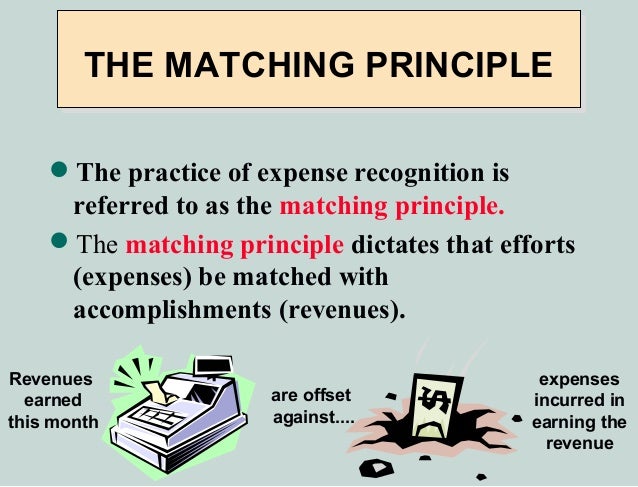The Matching Principle Requires That. Businesses must incur costs in order to generate revenues. Your current pay period ends on april 24, but your next pay date is may 1.

Matching principle is one of the most fundamental principles in accounting. The company determines that the interest expense on a note payable for period ending december 31st is $775. The matching principle requires that the rent must be allocated on an appropriate basis to each accounting period.
What Is Matching Principle Example?
Expenses and revenues are recorded in the period in which cash is received expenses are recorded in the period they are incurred, revenues are recorded in the period cash is received. The matching principle, part of the accrual accounting method, requires that expenses be recognized when obligations are (1) incurred (usually when goods are transferred, such as when they are sold or services rendered) and (2) the revenues that were generated from those expenses (based on cause and effect) are. Matching principle is the accounting principle that requires that the expenses incurred during a period be recorded in the same period in which the related revenues are earned.
Oo In The Same Period In Which The Revenue
That expenses be ignored if their effect on the financial statements is unimportant to users' business decisions. It requires that a company must record expenses in the period in which the related revenues are earned. Matching principle is the accounting principle that requires that the expenses incurred during a period be recorded in.
What Does Matching Principle Mean?
The matching principle requires the company to match 1/12 of the annual property tax to each month when revenues are earned as a result of the property. Ideally, the matching is based on a cause and effect relationship: The principle that requires a company to match expenses with related revenues in order to report a company's profitability during a specified time interval.
Content Accurate Reporting What Is The Difference Between Matching Principle And Revenue Recognition Principle?
Using the matching principle usually requires an accrual entry. This principle recognizes that businesses must incur expenses to earn revenues. Here are some additional examples of the matching principle and the adjusting journal entries:
The Amount Of Wages Your Employees Earn Between April 24 And May 1 Amount To $4,150.
Definition matching principle requires that expenses incurred by an organization must be charged to the income statement in the accounting period in which the revenue, to which those expenses relate, is earned. The expense recognition (matching) principle requires that expenses get recorded in the same accounting period as the revenues that are earned as a result of the expenses, not when cash is paid. They are usually paired up against revenue via the matching principle at the same time as the revenues sales revenue sales revenue is the income received by a.
Related Posts
- Are U Gonna Finish That CroissantAre U Gonna Finish That Croissant. About press copyright contact us creators advertise developers terms privacy policy & safety how youtube works ...
- States That Start With MStates That Start With M. There are 8 states that start with:montanaminnesotamichiganmissourimarylandmassachusettsmainemississippi. Capital largest ( ...
- What Evidence Do Paleobotanists Look For That Indicates The Movement Of Plants From Water To LandWhat Evidence Do Paleobotanists Look For That Indicates The Movement Of Plants From Water To Land. A) waxy cuticle to decrease evaporation from leave ...
- Principle Of Substitution Real EstatePrinciple Of Substitution Real Estate. The principle of substitution is the basis for the market data approach to appraisal. The three approaches to ...
- Words That Have The Root Word GraphWords That Have The Root Word Graph. Found 86 words that start with graph. These words have the common root “graph” which means:Parsing from text to ...
- Adjectives That Start With F To Describe A Person PositivelyAdjectives That Start With F To Describe A Person Positively. Adjectives starting with g!all the adjectives that start with g to describe a person po ...
- To Be Successful What Must An Entrepreneur Be Willing To Invest Check All That ApplyTo Be Successful What Must An Entrepreneur Be Willing To Invest Check All That Apply. To be successful, an entrepreneur must be willing to invest mon ...